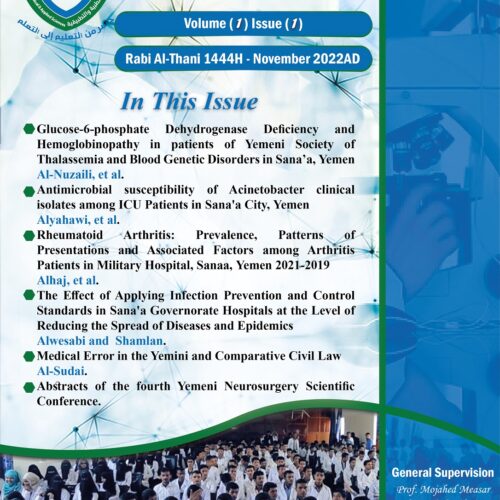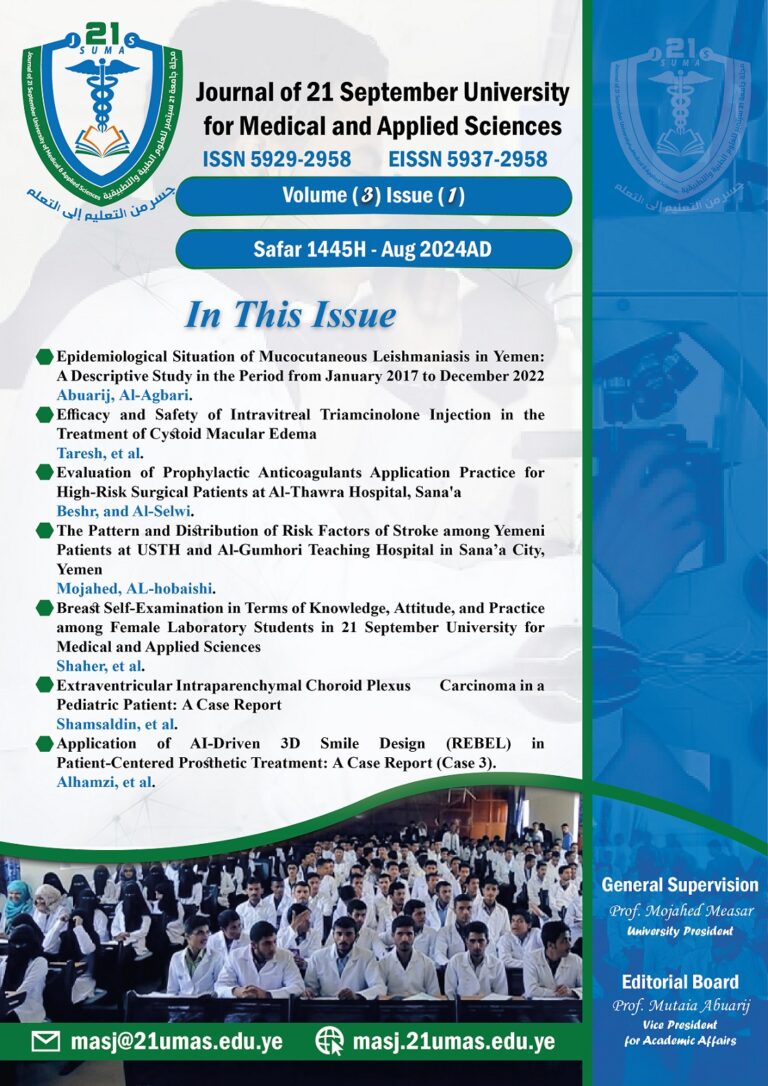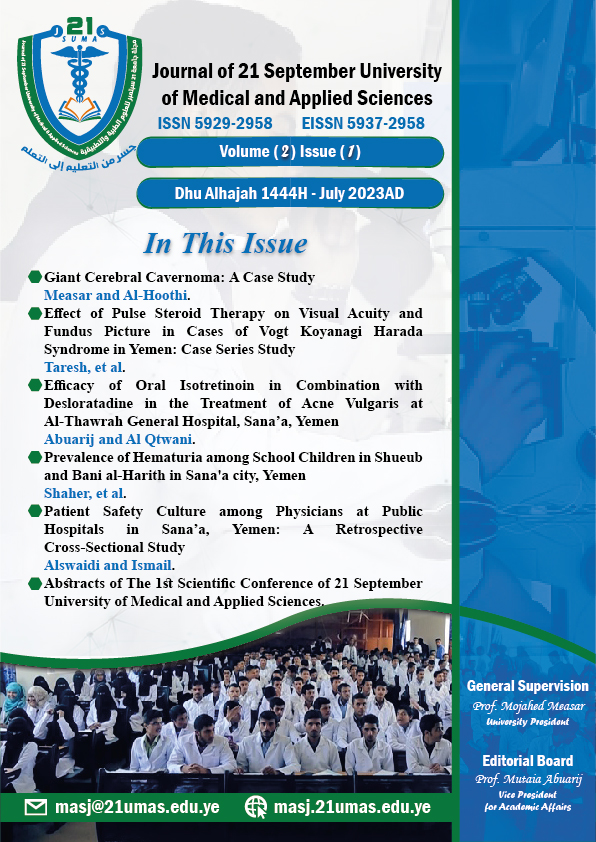In This Issue
- Glucose-6-phosphate Dehydrogenase Deficiency and Hemoglobinopathy in patients of Yemeni Society of Thalassemia and Blood Genetic Disorders in Sana’a, Yemen Al-Nuzaili, et al.
- Antimicrobial susceptibility of Acinetobacter clinical isolates among ICU Patients in Sana’a City, Yemen Alyahawi, et al
- Rheumatoid Arthritis: Prevalence, Patterns of Presentations and Associated Factors among Arthritis Patients in Military Hospital, Sanaa, Yemen 2021-2019 Alhaj, et al
- The Effect of Applying Infection Prevention and Control Standards in Sana’a Governorate Hospitals at the Level of Reducing the Spread of Diseases and Epidemics Alwesabi and Shamlan
- Medical Error in the Yemini and Comparative Civil Law Al-Sudai
- Abstracts of the fourth Yemeni Neurosurgery Scientific Conference #
Volume-1-Issue-1-20-Nov-2022
# Glucose-6-phosphate Dehydrogenase Deficiency and Hemoglobinopathy among Patients of the Yemeni Society of Thalassemia and Blood Genetic Disorders in Sana’a, Yemen
Mohammed AK Al-Nuzaili, Saleh A Bamashmoos, Lutfi AS Al-Maktari and Khaled AK Al-Moyed
Background: Glucose-6-phosphate dehydrogenase (G6PD) deficiency and hemoglobinopathies such as sickle cell anemia (SCA), sickle cell trait (SCT), and thalassemia are the most common congenital causes of hemolysis. The study aimed to determine the prevalence of G6PD deficiency in hemoglobinopathy patients and its effect on RBC indices.
Materials and methods: This case-descriptive study was carried out on a total of 100 hemoglobinopathy patients (51 males and 49 females) aged between 3 and 38 years. They attended the Yemeni Society for Thalassemia and Genetic Blood Disorders (YSTGBD) in Sana’a, Yemen, during the period between January and February 2021. Hb electrophoresis and/or HPLC methods were used to categorize them as sickle cell anemia (HbSS; n = 70), sickle cell trait (HbAS; n = 12), HbS/thalassemia major (n = 12), and HbS/thalassemia minor (n = 6). Five milliliters of venous-EDTA blood were collected from each patient and used to determine G6PD activity and the complete blood count (CBC). Data were analyzed using SPSS version 26 software.
Results: G6PD deficiency was detected in 29 (29.0%) of patients with hemoglobinopathy, of whom 16 (16.0%) were males and 13 (13.0%) were females. G6PD deficiency was discovered in 20 (20%), 3 (3%), 5%, and 1% of patients with HbSS, AS, S/β-thalassemia major, and minor hemoglobinopathies, respectively. In G6PD-deficient patients, G6PD activity significantly correlated positively with RBC (p= 0.048), MCH (p= 0.040), and MCHC (p= 0.002).
Conclusion: The prevalence of G6PD deficiency was high among hemoglobinopathy patients, particularly those with sickle cell anemia (SCA), which may contribute to a further increase in the hemolysis of RBCs. Therefore, screening hemoglobinopathy patients for G6PD levels is recommended during diagnosis and treatment.
Keywords: Glucose-6-phosphate Dehydrogenase (G6PD), Hemoglobinopathy, Sickle cell anemia (SCA), Sickle cell trait (SCT) and β-thalassem
# Antimicrobial susceptibility of Acinetobacter clinical isolates among ICU Patients in Sana’a City, Yemen
Ali Alyahawi, Muneer Alwesabi and Ali ALKaf
Drug resistant Acinetobacter strains are important causes of nosocomial infections that are difficult to control and treat. This study aimed to determine the antimicrobial susceptibility patterns of Acinetobacter strains obtained from ICU patients belonging to different age groups at hospitalized patients in Sana’a, Yemen. 88 Acinetobacter isolated were collected from the infected patients admitted to the ICU at a private hospital in Sana’a, Yemen, over one year from March 2020 to April 2021. The records were taken from the microbiology department for hospitalized patients. The results showed that out of 88 samples, 87 (98.8%) were Polymyxin B sensitive isolates and only one sample (1.2%) was resistant. Also, the Colistin sensitive isolates were observed in 100% of culture samples. This study found that 94.3% of culture samples were amoxicillin resistant and 90.9% were ampicillin\sulbactam resistant. In addition, Acinetobacter spp. resistance for imipenem, moxifloxacin, meropenem, cefepime, ceftazidime, and ceftriaxone was 95.5, 96.6, 95.5, 97.7, 97.7, and 97.7 %; respectively. The study also revealed the alarming trends of resistance of Acinetobacter strains for the various classes of antimicrobials. It was concluded that improvement of microbiological techniques for earlier and more accurate identification of bacteria is necessary for the selection of appropriate treatments. More careful monitoring for use of broad-spectrum antibiotics should be instituted.
Keywords: Acinetobacter, Antibiotic resistance, Carbapenems, ICU
# Rheumatoid Arthritis: Prevalence, Patterns of Presentations and Associated Factors among Arthritis Patients in Military Hospital, Sana’a, Yemen 2019-2021
Akram Yahya Alhaj, Ashjan Al Wazeer, Samah Abdulrasheed Abdulhafed, and Mohammed Al Dhabiani
Background: Rheumatoid arthritis (RA) is a systemic autoimmune disease characterized by inflammatory arthritis and extra-articular involvement.
Objective: This study aimed to portray the prevalence and associated factors of rheumatoid arthritis among arthritis patients in Military hospital, in Sana’a, Yemen.
Methods: It was a facility-based prospective cohort study. From a total of 650 diagnosed patients, one hundred patients with RA were selected and evaluated. Data was collected using a researcher-administered questionnaire and analyzed by SPSS to compare patterns of presentation of RA and its associations with socio-demographic and clinical characteristics.
Results: In the present study of 650 patients with arthritis, out of 200 diagnosed cases of RA, only 100 patients who completed a routine follow-up were eligible for inclusion. 89% were females and the most frequent age was 31-50 years with age mean of 40.5 ± 15.5 and 60% were from Sana’a. Only 5% of patients had a Family history of RA. The most associated comorbidities were HTN, DM and gout. RF and Anti-CCP were positive among 57% and 98%, respectively. 64% of patients had a normal echo exam, while the most diagnosed disease at echo exam was hypertensive heart disease followed by rheumatic heart disease. Male patients with RA had more than four odds to have another autoimmune disease (OR = 4.87; CI:1.29-18.32; P = 0.011). Most patients with exacerbations showed low Vit D deficiency (80%), UTI (40%), and hypocalcemia (30%).
Conclusion: It was concluded that RA is one of the most common autoimmune diseases among Yemeni arthritis patients and most affected females in the middle ages. Concurrence between RA with other autoimmune diseases was seen especially SLE and hypothyroidism, with most patients presenting with disease exacerbations. HHD and RHD were the most encountered on echo screening. The study recommended standardizing the management of RA cases based on the updated guidelines internationally to decrease exacerbations and raise awareness among doctors and patients about the major exacerbating factors for the disease.
Keywords: Rheumatoid Arthritis, presentations, exacerbations, Arthritis, Yemen.
#The Effect of Applying Infection Prevention and Control Standards in Sana’a Governorate Hospitals at the Level of Reducing the Spread of Diseases and Epidemics
Muneer Alwesabi1, Mohammed Shamlan
This study aimed to identify the level of commitment of Yemeni hospitals in Sana’a governorate in the application of infection prevention and control standards, and the extent of their impact on the level of disease outbreaks and epidemics in the governorate. To achieve the aim of the study, the descriptive approach was adopted with its both survey and analytical parts. In addition, the questionnaire tool, and assessment and observation tool for methods and means of infection control were used to obtain the study data. The study came to the conclusion that the hospitals of Sana’a governorate apply infection prevention and control standards merely to a medium degree. The risk and probability of disease and epidemic spread in the governorate was 39%, which is high in comparison with the global standard. The study also showed a statistically significant effect and an average positive correlation between the level of application of infection prevention and control standards and the level of limiting the spread of diseases and epidemics in the governorate. The study came out with a set of recommendations, the most important of which are: the necessity of adopting and developing procedural work guides (policies and procedures), by the Ministry of Health, to implement infection control programs, and activating the follow-up and strict control system that ensures the implementation of infection prevention and control standards efficiently and effectively by administrations and workers. It also recommended organizing training programs on the mechanism for the application of infection prevention and control standards, and working to create job and living stability for workers as well.
Paper-4-20-11-2022#Medical Error in the Yemini and Comparative Civil Law
Sadeq Motea Hasan Al-Sedeai
The doctor is obligated to provide the appropriate treatment to the patient, and to take the care required by the principles of the medical profession. The doctor’s relationship with the patient is a human relationship, and at the same time, it is a legal relationship. According to this relationship, consensus was held in most Arab and foreign legislation to hold the doctor accountable when he commits a negligence in his medical behavior that is not in agreement with the behavior of an attentive physician found in the same special circumstances that surrounded the physician in charge, with due regard for the same specialty. The scientific development has contributed to the cure of many diseases. However, this development was accompanied by risks on bad effects due to medical errors. This study focuses on the practicing system of medical professions in Yemen, and how the Yemeni law addresses the doctor’s civil responsibility for the medical and professional mistakes. It also examines the nature of the doctor’s medical responsibility, the standards for the doctor’s commitment in taking care of the patient, the time when the doctor is asked about his mistakes, the criteria by which the mistake can be assessed, and the means that can be used to prove the medical mistake. Due to the lack of the legal rules, as well as the lack of specialized researches and studies in the Yemeni library in relation to this study’s topic, this research intends to achieve the objectives mentioned above to provide solutions for controlling the phenomenon of medical errors, which is still an area that many countries, including Yemen, worry about.
Paper-5-20-11-2022#Abstracts of the fourth Yemeni Neurosurgery Scientific Conference
Trigeminal Neuralgia MVD: surgical Management & follow-up of 400 cases
.
Abstracts-of-the-4th-Yemeni-Neurosurgery-Scientific-Conference-

